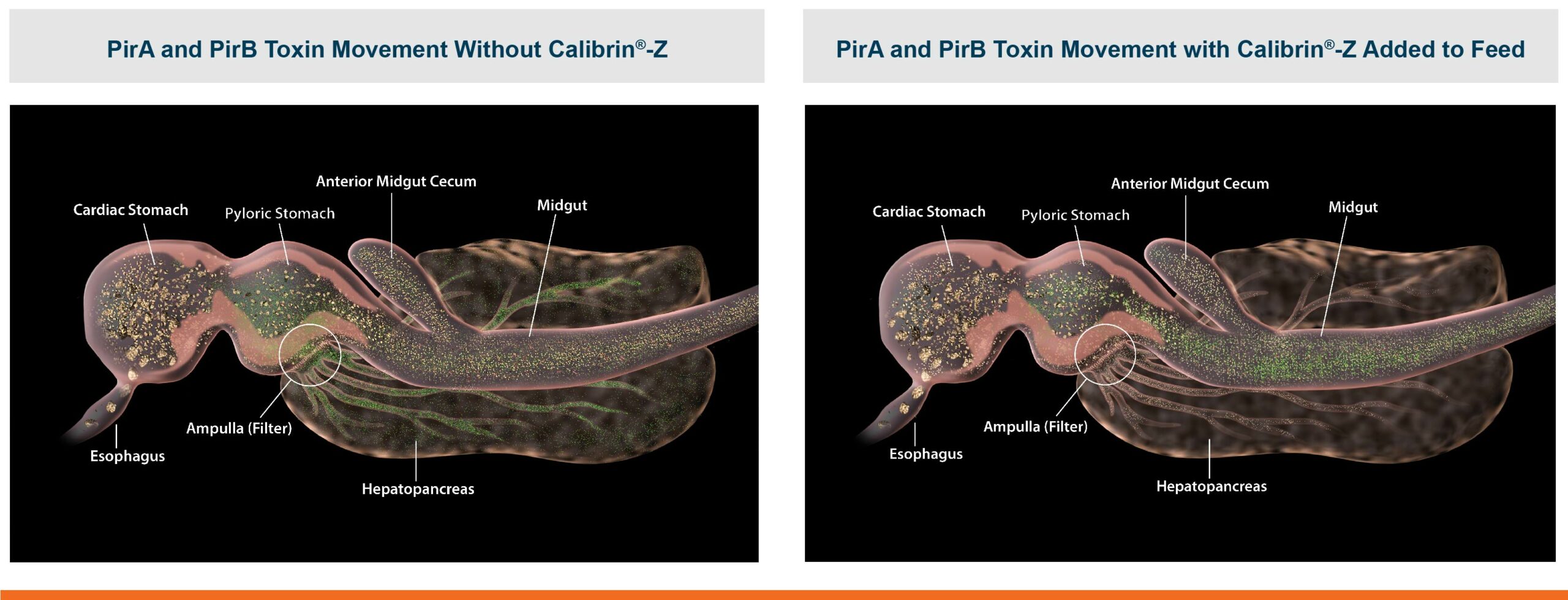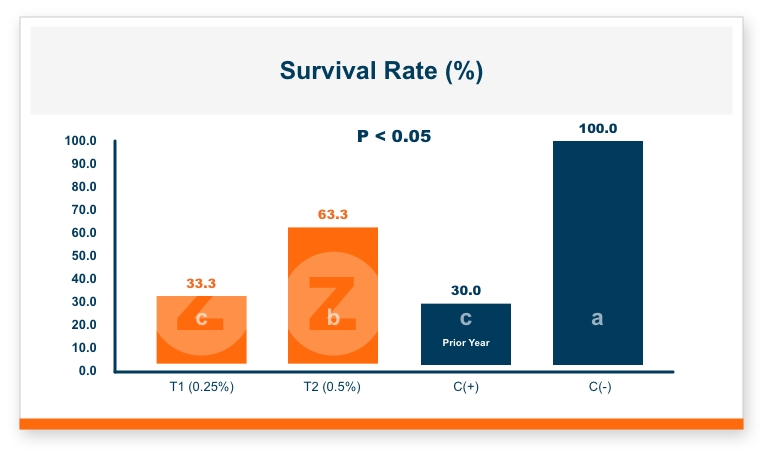Product availability may vary by country, associated claims do not constitute medical claims and may differ based on government requirements.
Acute hepatopancreatic necrosis disease (AHPND), originally called “early mortality syndrome,” costs the shrimp industry billions of dollars each year. Outbreaks of the disease have occurred in multiple countries around the world, leading to shrimp mortality and loss of income for many commercial farms. Here we discuss the etiology of AHPND and a natural solution for mitigating its effects.
The Bacteria Behind AHPND
The causative agent of AHPND is Vibrio parahaemolyticus, an orally transmitted bacteria that colonizes the shrimp gastrointestinal tract. V. parahaemolyticus produces a potent binary toxin that enters the hepatopancreas and causes dysfunction and destruction of this vital organ, often leading to mortality. Affected shrimp present with an abnormal hepatopancreas that is often reduced in size and shows whitening and hardening. However, very high mortality within a short period of time may be the first indication that a pond has been infected.
A Toxic Cause of Hepatopancreatic Cell Death
The specific strain of V. parahaemolyticus that causes AHPND was first identified by Dr. Lightner’s group at the University of Arizona, who also reported that the pathology was caused by a toxin secreted by V. parahaemolyticus.1 Lee et al. (2015) showed that the strains of V. parahaemolyticus that cause AHPND contain a plasmid (pVA1) that encodes the binary toxin PirABvp (Photorhabdus insect-related toxins PirAvp and PirBvp) and that this toxin leads to the death of shrimp hepatopancreatic cells.2
Natural Protection from AHPND
Protecting shrimp from the damaging effects of AHPND requires consideration of multiple factors, including biosecurity measures and other production practices that reduce the risk of disease. However, a natural mineral-based solution, Calibrin®-Z (available in select international markets), is also available to help protect shrimp from AHPND and the devastating production losses it causes.
Calibrin-Z is a broad-spectrum biotoxin binder manufactured from a single ingredient — Amlan’s unique mineral technology. Calibrin-Z is optimized via proprietary thermal processing and binds mycotoxins and certain endo and exotoxins produced by pathogenic bacteria, helping to defend the intestinal tract from enteric disease.
When bacterial toxins (and mycotoxins) flow through the gastrointestinal tract, they are bound by Calibrin-Z and thus prevented from entering the hepatopancreas. The bound toxin is removed through normal digestive function (Figure 1). To provide optimal protection against AHPND, Calibrin-Z should be fed consistently from the beginning to the end of the growing cycle.

Figure 1: Calibrin-Z helps prevent PirA and PirB toxins from entering the hepatopancreas by binding the toxins. The bound toxin is removed through normal digestive function.
Research Proves Protective Effect of Calibrin-Z
A number of studies have shown the protective benefits of adding Calibrin-Z to shrimp diets. Here we present a commercial farm case study as well as two university-based studies that demonstrate the health, performance and economic benefits of Calibrin-Z.
Commercial Case Study Shows Strong ROI
In this study at a commercial farm in Mexico, shrimp were fed either probiotics and charcoal (control group, five ponds) or Calibrin-Z (5 kg/MT feed, four ponds) from post-larvae to market weight (approximately 90 days). Each pond (5 ha) was stocked with 1 million shrimp. An AHPND outbreak did not occur during this trial.
Shrimp fed Calibrin-Z had greater average weekly weight gain (P < 0.1), improved feed conversion at harvest (P < 0.05) and reached harvest time (14 g weight) six days earlier (Figure 2).

Figure 2: Calibrin-Z improved shrimp performance compared to shrimp fed probiotics and charcoal.
Calibrin-Z Provides Hepatopancreatic Protection and Increases Survival Rates
Another study was conducted at Instituto Tecnológico de Sonora, Laboratorio de Analisis en Sanidad Acuícola (Aquatic Health Laboratory) in Obregon, Sonora, Mexico. White shrimp (Penaeus vannamei, 30 shrimp per treatment, three replications per treatment) were fed one of four treatments: negative control (no challenge), positive control (V. parahaemolyticus challenged), Calibrin-Z at 0.25% (challenged) or Calibrin-Z at 0.5% (challenged). The shrimp were fed twice a day for 20 days (fed for 15 days then challenged for 5 days). The positive control and Calibrin-Z groups were challenged by immersion with bacterial broth (TSB) containing V. parahaemolyticus (AHPND, strain 6V) via waterborne contact infection.
Calibrin-Z fed at 0.5% doubled the survival rate after experimental V. parahaemolyticus infection compared to the positive control (63.3% vs. 30%, Figure 3) and significantly improved cumulative mortality (Figure 4). A protective effect in the hepatopancreas was also observed in shrimp fed 0.5% Calibrin-Z compared to the positive control. Severity of AHPND histopathology (G0 = an absence of damage and G4 = severe tissue lesions) was 0 for the negative control, 4 for the positive control and 2 for Calibrin-Z fed at 0.5%. Calibrin-Z fed at 0.5% clearly shows significant improvement in shrimp survival rates.

Figure 3: Calibrin-Z fed at 0.5% doubled the survival rate of shrimp challenged with V. parahaemolyticus infection compared to the positive control (P < 0.05).

Figure 4: Cumulative mortality was improved by feeding Calibrin-Z to shrimp challenged with V. parahaemolyticus compared to the challenged control.
Enhanced Microbiota Diversity and Improved Survivability with Calibrin-Z
A study conducted at Universiti Sains Malaysia, Penang, Malaysia, looked at the benefits of Calibrin-Z on post-larval growth, gut health and disease resistance to AHPND. The researchers used triplicate groups of specific pathogen-free shrimp (Penaeus vannamei, 20 per replicate) and compared the performance and health of a negative control, positive control and Calibrin-Z fed at 0.25% or 0.5%. All groups were fed for 14 days and then a 7-day emersion challenge was conducted with all groups, except the negative control, using an AHPND-causing strain of V. parahaemolyticus.
Calibrin-Z at 0.25 or 0.5% did not affect growth, feed efficiency or survival during the 14-day unchallenged period. When challenged, shrimp fed Calibrin-Z at 0.25% and 0.5% had significantly higher survival rates (83.3 and 93.8%, respectively) compared to the positive control group (39.6%) and were not significantly different to the negative control (96.7%).
Presumptive Vibrio and total cultivable bacteria counts in the hepatopancreas were lower for shrimp fed Calibrin-Z, and histopathology of the hepatopancreas showed less damage compared to the positive control group. Calibrin-Z also enhanced the stomach microbiota diversity and appeared to modulate the bacterial community, which may have positively affected shrimp survival.
These studies demonstrate the benefits Calibrin-Z offers shrimp farmers as a natural solution for mitigating the production and profit-limiting effects of AHPND. The unique biotoxin-binding features of Calibrin-Z help provide protection against bacterial toxins like PirA and PirB as well as mycotoxins in the feed. For more information on how Calibrin-Z can benefit your farm, visit amlan.com or contact your local Amlan representative.
References
- Tran L, Nunan L, Redman RM, Mohney LL, Pantoja CR, Fitzsimmons K, Lightner DV. Determination of the infectious nature of the agent of acute hepatopancreatic necrosis syndrome affecting penaeid shrimp. Dis Aquat Org. 2013;105:45–55. https://doi.org/10.3354/dao02621.
- Lee CT, Chen IT, Yang YT, Ko TP, Huang YT, Huang JY, Huang MF, Lin SJ, Chen CY, Lin SS, Lightner DV, Wang HC, Wang AH, Wang HC, Hor LI, Lo CF. The opportunistic marine pathogen Vibrio parahaemolyticus becomes virulent by acquiring a plasmid that expresses a deadly toxin. Proc Natl Acad Sci USA. 2015;112:10798–10803. https://doi.org/10.1073/pnas.1503129112.

